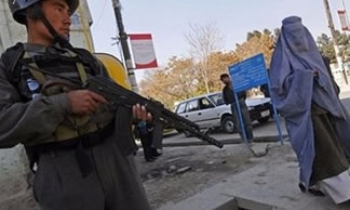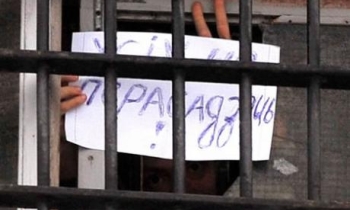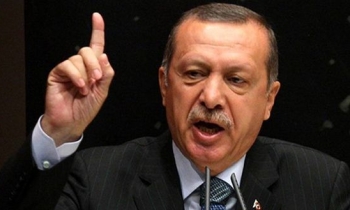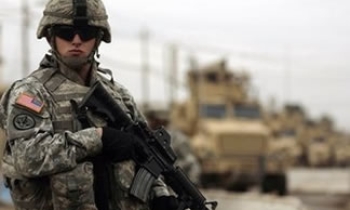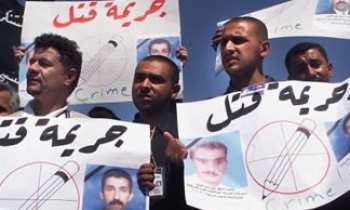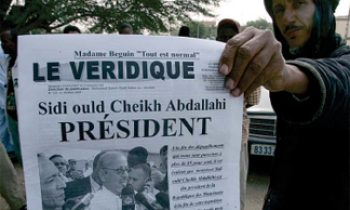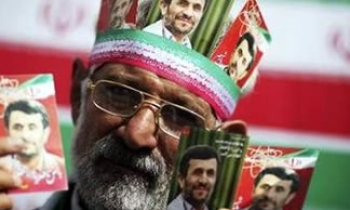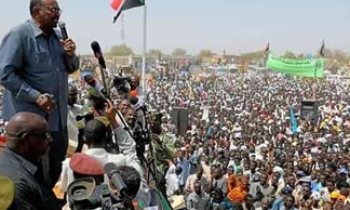September 17, 2005: Politiken, a Danish newspaper, runs an article under the headline "Deep fear of criticism of Islam" detailing the difficulty encountered by the writer K�re Bluitgen, who had difficulties finding an illustrator for his children's book on the life of Mohammed.
September 30: Jyllands-Posten, one of Denmark's bestselling daily newspapers, publishes 12 cartoons of the prophet to illustrate the problem.
October 9: Spokesmen for Denmark's Islamic Faith Community demand an apology from Jyllands-Posten.
October 12: Ambassadors from 10 Muslim nations and the Palestinian representative in Denmark call the cartoons deeply offensive and demand a meeting with Prime Minister Anders Fogh Rasmussen urging him "to take all those responsible to task."
October 14: About 5,000 people stage a peaceful demonstration outside the Copenhagen office of Jyllands-Posten. Two of the cartoonists are advised to go into hiding after receiving death threats
October 17: Egyptian Newspaper El Fagr publishes six of the cartoons during Ramadan along with an article strongly denouncing them. The publication of the images does not engender any known protests from either Egyptian religious authorities or the Egyptian government.
October 21: Rasmussen says offended parties should use the courts to air their grievances and refuses to meet the ambassadors.
October 28: A number of Muslim organisations file a complaint with the Danish police claiming that Jyllands-Posten committed an offence under section 140 and 266b of the Danish Criminal Code. A regional prosecutor investigates the complaint, but decides not to press charges.
November: Dutch newspaper De Volkskrant also publishes the cartoons.
November 3: German newspaper Frankfurter Allgemeine Zeitung publishes one of the cartoons. Bosnian newspaper Slobodna Bosna too does so.
December: A Danish Muslim coalition visits the Middle East seeking support from religious and political leaders. They show highly offensive drawings that have not been printed in Jyllands-Posten and which have nothing to do with the newspaper.
December 7: Louise Arbour, the UN High Commissioner for Human Rights expresses concern over the cartoons and says that United Nations is investigating racism of the Danish cartoonists.
December 19: Twentytwo former Danish ambassadors criticise the Denmark Prime Minister for not meeting the 11 Muslim ambassadors in October. The Council of Europe criticises the Denmark for invoking the "freedom of the press" in its refusal to take action against the "insulting" cartoons.
January 1, 2006: Rasmussen condemns any actions that "attempt to demonise groups of people on the basis of their religion or ethnic background,'' but reiterates Denmark's commitment to freedom of speech.
January 4: Amr Moussa, Secretary-General of the Arab League, joins the protests.
January 7: Two pictures are printed in the Swedish newspaper Expressen and its sister editions Kv�llsposten and GT.
January 10: Magazinet, a Norwegian Christian newspaper, reprints the cartoons.
January 22: The Brussels Journal publishes the cartoons.
January 25: Saudi Arabia's religious leaders demand an apology and call for the Jyllands-Posten newspaper to be punished.
January 26: Saudi ambassador is recalled from Copenhagen. Danish companies in Riyadh report a boycott of Danish goods and supermarkets remove products from the shelves. Norwegian Ministry of Foreign Affairs sends a letter to its ambassadors in the Middle East stating that one of the pillars of Norwegian society is freedom of speech, but expresses regret that Magazinet did not respect Muslims' beliefs.
January 27: Protests begin to spread across Middle East.
January 28: Danish ambassador in Saudi Arabia is interviewed by Associated Press Television News (AP-TV) where he criticises Jyllands-Posten's lack of judgement and knowledge of Islam, even though the Danish government has not spoken on the matter.
January 29: Libya closes its embassy in Denmark. In an interview with al-Jazeera, Jyllands-Posten's culture editor expresses regret that the drawings printed in the newspaper unwittingly offended practising Muslims. This expression is not translated into Arabic. Danish government announces that its ambassador to Saudi Arabia only expressed his own opinion in the interview with AP-TV. Danish People's Party, Dansk Folkeparti, demands he be reprimanded. President of Afghanistan Hamid Karzai calls the printing of the cartoons a mistake, and hopes that this will lead to the media being more responsible and respectful in the future. Ekstra Bladet reveals that a Danish Muslim association spreading the story in the Middle East, has claimed that it represents 200,000 Danish Muslims. Its actual membership number is around 15,000.
January 30: Jyllands-Posten's editor-in-chief publishes a statement on the Internet in Danish, English, and Arabic and apologises for the offence the drawings have caused, but not the publishing of the drawing themselves, as this is not in conflict with either Danish law or the ethics of the Danish press. Gunmen from Al-Aqsa Martyrs Brigades storm the European Union's office in Gaza and threaten to kidnap the workers unless they receive an official apology for the cartoons from EU. Mexican newspaper La Crónica is the first Western newspaper to reprint the Danish cartoons. European Union backs Denmark, saying that any retaliatory boycott of Danish goods would violate world trade rules. A Iraqi militant islamic organisation, the Mujahideen Army, calls for terror strikes against Danish and Norwegian targets.
January 31: Rasmussen calls for calm in the dispute, but the Danish Muslims group says the Jyllands-Posten apology is "ambiguous" and demands a clearer one. Following a live televised interview on Al-Jazeera, it is reported that the "apology for any offence caused" made at the opening of the interview by Flemming Rose, Jyllands-Posten's cultural editor, was not translated into Arabic. Bomb threat against Jyllands-Posten leads to evacuation of two offices in Aarhus and Copenhagen. Icelandic newspaper DV publishes six of the twelve cartoons. German newspaper Die Tageszeitung publishes two. In Greece, Eleftherotipia publishes one.
February 1: French newspaper France Soir publishes the cartoons, adding one of its own. Managing director Jacques Lefranc fired later the same day by owner Raymond Lakah, a French-Egyptian binational and Roman Catholic (the chief editor, Serge Faubert, is not fired). French Government dissociates itself from the initiative. German newspaper Die Welt publishes some of the cartoons, as do German newspapers Tagesspiegel and Berliner Zeitung, Italian newspaper La Stampa, Spanish newspaper El Periódico de Catalunya, Dutch papers Volkskrant, NRC Handelsblad, and Elsevier. Syria recalls its ambassador from Denmark. Jyllands-Posten's headquarters as well as its office in Copenhagen is again evacuated after a bomb threat.
February 2: German newspaper Die Zeit publishes one of the cartoons. Jordanian newspaper al-Shihan too prints the cartoons. Newspaper's manager is fired. American newspaper New York Sun publishes two, Belgian newspaper Le Soir publishes two, French newspaper Le Monde publishes a cartoon of Muhammad's face formed only from words that read "I may not draw the Prophet", Swiss newspapers Le Temps and Tribune de Genève publish some of the cartoons, as does the Hungarian newspaper Magyar Hirlap, Uruguayan newspaper Terra prints all 12. Portuguese newspaper Público publishes one of the cartoons - the most heated one - Muhammad with a bomb on his head, as does Argentine newspaper Página/12. Director of the Sakharov Museum in Moscow says the museum will do an entire exhibition about the cartoons. He also wants to illustrate the new Russian edition of Salman Rushdie's Satanic Verses with the original Danish cartoons. Danish Ministry of Foreign Affairs of Denmark advises its citizens to leave Gaza. "Fleeting glimpses" of some cartoons are shown in British television news programmes on BBC, ITV and Channel 4. On its flagship current affairs programme Newsnight, BBC recreates portions of the cartoons but with the image of Mohammed edited out. Roman Catholic bishops of the five Nordic countries deplore the publication of the cartoons. Al-Aqsa Martyrs Brigades storms the European Union's office in Gaza for the second time in a week and kidnaps a German national, who is later released unharmed. The NewsHour with Jim Lehrer on PBS displays some of the cartoons in its segment on the issue. British Islamist group Al Ghurabaa publishes an article entitled 'Kill those who insult the Prophet Mohammed', justifying such action using the Qur'an and Hadith, and applying its argument primarily to Jyllands-Posten, Magazinet and to the Danish and Norwegian governments. British National Party publishes cartoons on its website.
February 3: Danish Prime Minister Anders Fogh Rasmussen meets several Muslim ambassadors in Copenhagen. Egyptian ambassador responds that Rasmussen's response is inadequate and that Denmark should try harder to 'appease the whole Muslim world'. Belgian newspaper De Standaard publishes the cartoons, another, Het Volk, prints cartoons of Mohammed by Flemish cartoonists and quotes Etienne Vermeersch as saying Belgian papers should publish such caricatures every week "so that Muslims can get used to the idea." New Zealand weekly newspaper National Business Review prints one. The Times of India, Patna, prints the 12 cartoons. Muslims burn copies of the paper. British foreign secretary Jack Straw praises British media for not publishing the cartoons and condemns decision of European newpapers who published the cartoons as "disrespectful." Costa Rican newspaper Al DÃa publishes the cartoons, in Honduras El Heraldo too prints them. Australian broadcasters Special Broadcasting Service (SBS) and the Australian Broadcasting Corporation (ABC) show images of some of the cartoons in their evening news bulletins. Hundreds of Muslims march from the London Central Mosque to the heavily protected Danish embassy. Chants include "7/7 is on its way" and placard slogans include "Slay [also "butcher", "massacre" and "behead"] those who insult Islam", "Free speech go to hell", "Europe is the cancer and Islam is the cure", "Exterminate those who slander Islam", "Europe you will pay. Your 9/11 is on its way!!" and "Be prepared for the real holocaust!" Controversial Danish imam Abu Laban and the editor of culture of Jyllands-Posten meet on the BBC programme Hard Talk. Saudi cleric Sheikh Badr bin Nader al-Mashar refers, in an audio message posted online, to the cartoon furore as "part of the war waged by the decadent West against the triumphant Islam" and issues a call "to the billion Muslims: where are your arms? Your enemies have trampled on the prophet. Rise up." Canada's CTV television network news broadcasts a brief static close up of the cartoons. Irish Daily Star publishes one; accompanying article states that it wishes to "make a stand for freedom of the press and democratic rights". A Muslim judge pre-emptively bans publication of the cartoons in South Africa following a request for an urgent interdict by the Muslim Jamiat-ul Ulama Transvaal organisation. Belgian newspaper La Libre Belgique prints a game in which people have to connect the dots in order to find the image of Mohammed.
February 4: New Zealand daily Dominion Post prints the cartoons and an accompanying article, including text from the Wikipedia article on the topic. Polish newspaper Rzeczpospolita publishes the cartoons, much like the most influential Czech daily MF DNES. Danish newspaper Dagbladet Information publishes 12 Anders Fogh Rasmussen cartoons. Editor of Jordanian newspaper al-Shihan, Jihad Momani, is arrested. The building, which houses the Chilean, Swedish, and Danish embassies in Damascus Syria, is set on fire after being stormed by a mob. Several demonstrations in Hiller�d, Denmark collide and become violent. One demonstration is arranged by a small nationalistic group and included at least one Neo-Nazi. Other groups represented were Muslims, Danish anti-racists, and a group well known to the police for becoming violent. Vatican says the right to freedom of expression does not imply the right to offend religious beliefs, but also that a government should not be held responsible for actions of a newspaper. UN Secretary-General Kofi Annan calls for calm and urges Muslims to accept an apology from the Danish paper that first published the cartoons. A new network of Danish Muslims (called Moderate Muslims) is formed as a response to the cartoon controversy, with the Danish Muslim member of parliament Naser Khader as one of the founding members. An editorial in Wall Street Journal says the controversy was fuelled by Danish Muslims who added three non-published images to the cartoons. The additions involve one with a pig's nose on a man's face, another stating that Mohammed is a paedophile, and a third showing an indecent act with a dog. Jyllands-Posten is revealed to be the winner of the annual "Victor prize" given by rival Ekstra Bladet, for defending the freedom of press even under heavy pressure. German centre of culture in Gaza strip was ravaged by demonstrators. Rumours that Danes would burn the Qur'an circulated in the Arab world. Probable source of rumor is an SMS spread by Danish rightwingers, who told people to buy and burn the Qu'ran at a demonstration on February 4 in Copenhagen. This did not take place. Danish newspaper Politiken reveals that Jyllands-Posten in 2003, denied an unsolicited submission that caricatured the resurrection of Jesus, with the reason, that it would lead to an outcry.
February 5: Iran recalls its ambassador from Denmark and bans journalists. Danish consulate in Beirut set ablaze during a demonstration. In Copenhagen, Danish Minister of Foreign Affairs Per Stig M�ller assures that no Qur'an burnings had taken place in Denmark, and urged all parties to "talk down the crisis" so that they could "move forward together". The Arab European League, a conservative Arab nationalist organisation, puts several anti-Semitic cartoons on its website. Syrian state-owned newspaper Al-Thawra claims that the Danish government is responsible for having the embassy burned down. Lebanese Interior Minister, Hassan Sabeh, announces his resignation in reaction to the torching of the Danish consulate in Beirut, and to the subsequent criticism. Charges against two Jordanian editors that published the cartoon are dropped.
February 6: Australian blogger Tim Blair publishes the twelve cartoons on his website. Ukrainian newspaper Segodnya and Slovenian newspaper Mladina publish several cartoons. Three die in Afghan demonstration against the cartoons. Danish soldiers in Iraq are shot at while trying to give first aid to 10-15 Iraqi children who were hit by a truck in a traffic accident. The soldiers manage to save some of the children and bring them to a hospital. Danish Ministry of Foreign Affairs of recommends not spending holidays in Egypt, Morocco, Tunisia, Algeria, Libya, Sudan, Oman, United Arab Emirates, Qatar, Bahrain, Jordan, Iran, Pakistan, and Afghanistan. Ahmed Akkari, spokesman for 29 Muslim organisations in Denmark, offers to go on Arab television with Danish Prime Minister Anders Fogh Rasmussen in order to explain why it is not the Danish Prime Minister or the Danish Queen who should provide apologies. Lebanon apologises to Denmark for not having protected the consulate well enough. Embassy of Austria in Tehran attacked by firebombs. British Prtime Minister Tony Blair expresses his full support and solidarity with Denmark, as does Secretary General of NATO, Jaap de Hoop Scheffer. Israeli newspaper, The Jerusalem Post, prints the drawings, although very small, almost impossible to see. Danish embassy in Indonesia shuts down in order to secure employees. Grand Mufti of Syria is sorry that the relationship with Denmark has deteriorated, but hopes to restore it as soon as possible. Danish Refugee Council, the largest humanitarian aid organisation in Chechnya and supplier of food for 250,000 people in Chechnya and Dagestan, is asked by the government of Chechnya to leave the country. The organisation also has problems with delivering humanitarian aid in Sudan. Ferial Haffajee, editor of South African newspaper Mail and Guardian, which reprinted the cartoons, reports receiving threats. Iranian newspaper, Hamshahri, announces a competition for cartoons on the Holocaust. A man in Aarhus, Denmark files charges against Jyllands-Posten both for blasphemising and, in doing so, harming the country. Terry Davis, secretary general of the Council of Europe, says that the publication of the cartoons crossed an ethical line even if it still was legal. Danish illustrator Christoffer Zieler reports that in April 2003 he submitted a series of satirical cartoons about the resurrection of Christ to Jyllands-Posten, but they were turned down by the editor, who said "I don't think Jyllands-Posten's readers will enjoy the drawings. As a matter of fact, I think that they will provoke an outcry. Therefore, I will not use them."
February 7: Thousands of protesters clash with police and NATO peacekeepers in Afghanistan. Four demonstrators are killed in an attack on a Norwegian-led military base in Maymana, capital of the Faryab province in western Afghanistan. Ali Khamenei, spiritual leader of Iran, expresses the hypocricy of Western media in publishing these cartoons during an address, to Iranian air force personnel. Nestlé publishes posters denouncing rumour that any of its products are Danish in origin. Defacement of Danish websites by Muslim hackers reaches 578 within 1 week. Prime Minister of Italy, Silvio Berlusconi, asks Turkey to "neutralise fanatics", after the murder of an Italian Roman Catholic priest. Taliban urges Muslims to declare Jihad over the cartoons. A student newspaper editor is suspended for publishing an image of Mohammed. Cardiff University's student union paper Gair Rhydd is the first UK publication to use the images, and recalls 8,000 of its copies. Editorial staff of alternative weekly New York Press walks out en masse, after the paper's publishers backed down from printing the cartoons. Yemeni government cancels publishing license of two private newspapers, Yemen Observer and Al-Hourriah for publishing the illustrations. In Lithuania, Respublika prints four of the controversial cartoons. Peter Mandelson, EU trade chief, warns Iran against suspension of trade with Denmark. Austria, holders of the EU presidency, demand Muslim states improve security measures for European citizens and premises after Norwegian embassy is attacked in Tehran. Russian President Vladimir Putin urges editors to "think 100 times" before publishing such pictures, but German foreign minister Frank-Walter Steinmeier says the controversy may be exploited to incite unrest in Muslim countries. Danish Imans want to end the dispute.
February 8: French weekly newspaper, Charlie Hebdo, publishes the 12 cartoons plus a new one representing Mohammed by French cartoonist Cabu. The new cartoon shows Mohammed with his head in his hands and is accompanied by the legend: "It is tough to be loved by morons" (C'est dur d'être aimé par des cons). French Muslim organisations, including the French Council of Muslim Faith (CFCM) and the Grand Mosques of Paris and Lyon had unsuccessfully sued Hebdo the day before to avoid this publication. Moderate Muslims to begin a campaign in Arab countries in favour of Denmark. Plans to use SMS and newspaper advertisements, paid for by Muslim members only. Picture claimed to be Mohammed cartoon dressed up as a pig is revealed to be a photo of the "pig-squealing" champion Jacques Barrot in France. Demonstrators burn Danish, Norwegian and Croatian flags in Sarajevo, the capital of Bosnia-Herzegovina following publication of the controversial cartoons in a Croatian weekly on February 6. Veja, Brazil's largest circulated magazine, publishes three of the original cartoons in both its print edition and on its website. Paraguayan newspaper La Papa too publishes several cartoons "Freedom for Egyptians" blog publishes scans reportedly showing six of the cartoons, including the turban bomb image, as published in the October 17, 2005 issue of Egyptian newspaper El Fagr. "Egyptian Sandmonkey" blog publishes its own (different) scans of the relevant pages from the October 17, 2005 issue of El Fagr. That no adverse reaction occurred at that time is taken by some to strengthen the argument that the controversy was sparked or stoked for political ends. Administration at the University of Prince Edward Island, Canada, orders a halt to the on-campus distribution of the student newspaper Cadre after the cartoons were reprinted in the newspaper. Campus authorities also attempt to seize all 2,000 copies of the edition. Prof Peter March at Saint Mary's University, Canada, is directed by the administration there to remove copies of the cartoons that he posted on his office door. The professor was later the subject of an on-campus student march, and claimed to have received anonymous messages stating that his actions may have repercussions for Canadians being held hostage in Iraq. US accuses Syria and Iran of inciting violence among Muslims over caricatures.
February 9: Egyptian newspaper El Fagr removes from its website the front page image of its October 17, 2005 edition which included six of the cartoons. Danish tabloid B.T. reports that Bjarne S�rensen, the Danish ambassador to Egypt, has confirmed reports that the cartoons were published in the Egyptian newspaper El Fagr on October 17, 2005. Venezuelan newspaper Últimas Noticias reprints the cartoons from Charlie Hebdo. Russian newspaper Volgograd Gorodskiye vesti prints one new cartoon featuring Mohammed. After the Japanese government urged newspapers not to print the controversial cartoons, several newspapers do print them, saying that the freedom of speech is absolute and the government should not intervene. The Japanese government does not react to the printing of these cartoons. BBC reports that, in a speech in Berlin, Ayaan Hirsi Ali (colleague of murdered filmmaker Theo van Gogh) said it was "correct to publish the cartoons" and that the furore over the cartoons had exposed the fear among artists and journalists in Europe to "analyse or criticise intolerant aspects of Islam". Swedish newspaper Dagens Nyheter reports that, although the foreign office and S�PO got Sverigedemokraterna's website shut down after publishing Mohammed caricatures, they are still available from its youth wing. The international row spills over into the creation of a new UN Human Rights Council. Hundreds of thousands of Shia Muslims turn a religious ceremony in Lebanon into an anti-western cartoon protest. Indonesia cancels a friendly badminton match against Denmark because of security concerns. Malaysian government shuts a local newspaper for publishing the cartoons while in Indonesia, police charge the editor of a weekly tabloid with blasphemy for reprinting them. The culture editor of Jyllands-Posten, Flemming Rose, is sent on holiday for an indefinite period by his boss.
February 10: Ahmad Abu Laban, Islamisk Trossamfund leader, strikes a different tune in his Friday prayer. He calls Denmark a nice and tolerant country and calls for the violence to stop. He also openly challenges Islam critic Ayaan Hirsi Ali. Russian newspaper Bryansk Subbota prints two cartoons of the Danish cartoons. The editor of Norwegian Christian newspaper Magazinet, Vebj�rn Selbekk, apologises for the reactions and consequences of the publication of the cartoons. Norwegian Muslim community accepts his apology and considers the issue closed. In former Yugoslav Republic of Macedonia, both newspapers Vreme and Vest print the twelve cartoons. Danish ambassadors and diplomatic staff in Iran, Syria, and Indonesia leave after receiving threats.
February 11: Naser Khader Muslim member of Danish parliament and one of the founding members of Moderate Muslims asks the Minister of Religion in Denmark to investigate Abu Laban words in the Friday prayer in the mosque at Dortheavej in Copenhagen where he described Ayaan Hirsi Ali as a rat in a hole. Euronews shows one of the cartoons in a newstrailer, which was originally from a TV programme from Switzerland.
February 12: Condoleezza Rice, US secretary of state, says violence sparked by the cartoons could get out of control and urged governments, especially Iran and Syria, to "act responsibly" and refrain from encouraging demonstrations.
February 13: Iranian ambassador in Berlin asks German daily Tagesspiegel to apologise for and "take all steps necessary for retribution of this immoral act", because it published a cartoon about soccer that "caused outrage and horror in Iran and worldwide". The cartoon accompanied an article (10 Feb 2006) that argued against the idea that it may be a necessary to have the German army support the police force in securing the soccer world championship 2006 in Germany. The cartoon depicts a soccer team (Iranian, say the amassadors) in a soccer arena, wearing suicide bomber belts, watched over by German army personnel. Caption: "That's why it's absolutely necessary to have the army around." The cartoonist receives three death threats. EU foreign policy chief Javier Solana meets Organisation of the Islamic Conference's (OIC) Secretary-General Ekmeleddin Ihsanoglu to defuse the crisis. Ihsanoglu calls upon EU Parliament to pass legislation to combat Islamophobia. Leading Iranian newspaper launches a competition asking people to submit cartoons about the Holocaust. The Hamshahri daily says the competition is to test the boundaries of free speech for Westerners. Australian cartoonist, Michael Leunig, becomes the victim of a hoax involving the cartoon competition Iranian newspaper, Hamshahri. Twentyfive Muslim graves are desecrated in Denmark. Kofi Annan, UN secretary-general, says that Iran, Syria and other governments that failed to protect foreign embassies from mobs should pay for the damage.
February 14: In South America both Peru's RPP Noticias and Chile's 24 Horas print the Danish cartoons. Finland's National Bureau of Investigation decides to conduct a preliminary investigation into the matter of the nationalist Suomen Sisu and others publishing the cartoons online. Finnish penal code has the same kind of section on the sanctity of religion as does Danish law. In Pakistan, over 1,000 rioters vandalise many western business establishments and torched the provincial assembly building. At least two people are killed. Italian minister Roberto Calderoli wears a t-shirt emblazoned with cartoons of Mohammed. Calderoli (a member of Lega Nord), says: "I have had t-shirts made with the cartoons that have upset Islam and I will start wearing them today. We have to put an end to this story that we can talk to these people. They only want to humiliate people. Full stop. And what are we becoming? The civilization of melted butter?" Amitai Sandy, a Jewish graphics design artist from Tel Aviv, starts an anti-semitic cartoon contest to be drawn by Jews. Tom Tomorrow makes a cartoon comparing the reactions to the Mohammed cartoons to the Tom Toles cartoons pointing out the double standards. Jose Manuel Barroso, EU Commission chief, backs Denmark, saying that freedom of speech cannot be compromised. But in fresh violence, two people are killed in the Pakistani city of Lahore, despite a province-wide ban on demonstrations. German embassy attacked in Tehran.
February 15: Three more people die in violence as outlets of the Norwegian phone company Telenor, a US KFC fast food restaurant and banks are ransacked and set alight in Pakistan.
February 16: Protests continue in Pakistan, where up to 50,000 rally in Karachi.
February 17: Pakistani cleric Mohammed Yousaf Qureshi announces a $1 million bounty for killing the [sic] cartoonist who drew the prophet. A crowd of over one thousand protesters storm the Italian consulate in Benghazi, Libya resulting in eleven deaths. Apparently, the protests were triggered by a provocation from the Italian reforms minister Roberto Calderoli, who resigned the day after. Danish and Norwegian embassies in Dar es Salaam, Tanzania closed offices. A newspaper in Mozambique, Savana publishes eight of the cartoons. Thousands of Muslims in Hong Kong march against the drawings of the prophet.
February 18: Stockholm's Fria Tidning publishes its own "Muhammad pictures", including Muhammad Ali, Muhammad Baqir al-Sadr, Mohammad Lawal, Haji Kher Muhammed, Muhammad Mahdi al-Salih and Amir Mohammed Rasheed. Italian Minister Calderoli resigns after pressures from Prime Minister Berusconi resulting from protests in Libya. Protest march in Copenhagen arranged by a network of Muslim academics. Approximately 3,000 people take part in a peace march with the message "more dialogue and peace amongst religions, cultures and Muslims". Russian newspaper Gorodskiye Vesti is shut down by the authorities after publishing a cartoon of Mohammed of its own. Nigerian Muslims attack Christians and burn churches, killing 15 people in the deadliest confrontation yet in the whirlwind of Muslim anger.
February 19: Approximately four hundred protesters attempted to storm the gates of the United States embassy in Jakarta, Indonesia, chanting anti-US slogans and burning American flags. Over four hundred protesters are arrested and many others are sprayed with tear gas in an attempt by police to suppress protests in Islamabad, Pakistan.
February 20: Danish newspaper Politiken reveals that the 11 ambassadors in their letter in October, also wanted to express their concerns over current issues regarding Islam. The Danish Prime minister has repeatedly said, that the letter only asked for the government to take action against Jyllands-posten. Pope urges respect for world religion and argues that people should try to avoid harming religious sensibilities
February 21: Christians riot in the city of Onitsha, Nigeria while Muslims riot in the city of Bauchi days after an anti-cartoon riots in Maidugugeri, another Nigerian city. At least 24 people have been killed in the two incidents. An Indian Minister in the state of Uttar Pradesh announces a bounty of Rs 51 crore (approx. $11.5 million) for anybody who kills one of the cartoonists. The Organisation of Islamic Countries (OIC) denounces cartoons violence and previous calls for the death of Danish cartoonists. Belarusian newspaper Zgoda prints the 12 cartoons, but is closed soon afterwards.
February 24: A Finnish editor of the newspaper Kaltio, Jussi Vilkuna, is fired after refusing to remove a Mohammed cartoon on the newspaper's website. This cartoon features a fearful westerner in the grips of a masked prophet Mohammed and Finnish politicians burning Danish flags. Over 120 people are killed in Nigeria in clashes between Christian and Muslim mobs following continued protests over the cartoons.
February 26: Over 25,000 people peacefully protest the cartoons in Karachi, Pakistan, shouting slogans such as "Down with the blasphemer," "Death to America," and "End diplomatic ties with European countries." Police arrested dozens of Muslim hardliners to prevent a protest in the Pakistani city of Lahore.
February 27: European Union (EU) expresses regret over the cartoons of Moha

